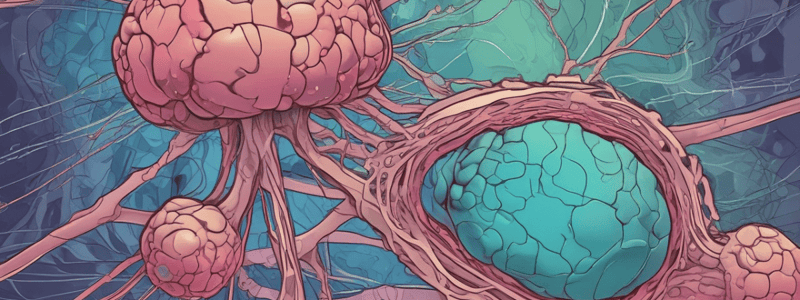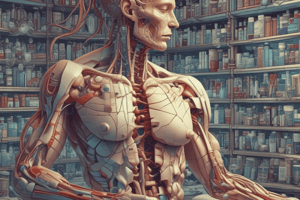Podcast
Questions and Answers
What is the primary mechanism of interaction between agonists or antagonists and their binding sites?
What is the primary mechanism of interaction between agonists or antagonists and their binding sites?
- Ion channels
- Second messenger systems
- Multiple sites of interaction (correct)
- Gated receptors
What is a critical factor in the binding of agonists or antagonists to their binding sites?
What is a critical factor in the binding of agonists or antagonists to their binding sites?
- The concentration of the agonist or antagonist
- The number of binding sites available
- The binding affinity of the agonist or antagonist (correct)
- The presence of other molecules in the binding site
What is the result of the interaction between an agonist and its binding site?
What is the result of the interaction between an agonist and its binding site?
- Enhancement of the response (correct)
- Complete blockade of the response
- No effect on the response
- Inhibition of the response
What is the primary function of antagonists in the binding site?
What is the primary function of antagonists in the binding site?
What is the consequence of the binding of an agonist or antagonist to its binding site?
What is the consequence of the binding of an agonist or antagonist to its binding site?
What is the primary characteristic of rigid bulky molecules with amine functions incorporated into ring structures?
What is the primary characteristic of rigid bulky molecules with amine functions incorporated into ring structures?
Which of the following techniques is NOT used to study neuromuscular blocking activity?
Which of the following techniques is NOT used to study neuromuscular blocking activity?
What do structure-activity relationships of NMBAs affect?
What do structure-activity relationships of NMBAs affect?
What is the common feature among mechanomyography, electromyography, kinemyography, and acceleromyography?
What is the common feature among mechanomyography, electromyography, kinemyography, and acceleromyography?
What has changed significantly in our understanding of NMBAs since their early classification?
What has changed significantly in our understanding of NMBAs since their early classification?
What is the primary factor that determines the speed of onset of neuromuscular block after administration of an NMBA?
What is the primary factor that determines the speed of onset of neuromuscular block after administration of an NMBA?
What is the minimum ED95 required for a rapid onset of effect of an NMBA?
What is the minimum ED95 required for a rapid onset of effect of an NMBA?
Why do equipotent doses of mivacurium have a slower onset of effect in patients who are homozygous for atypical butyrylcholinesterase?
Why do equipotent doses of mivacurium have a slower onset of effect in patients who are homozygous for atypical butyrylcholinesterase?
What is a necessary step for an NMBA to exert its effect?
What is a necessary step for an NMBA to exert its effect?
What is the primary mechanism of action of an NMBA?
What is the primary mechanism of action of an NMBA?
What is the relationship between the speed of onset of neuromuscular block and the speed of recovery of neuromuscular function?
What is the relationship between the speed of onset of neuromuscular block and the speed of recovery of neuromuscular function?
What is involved in binding the agonist or antagonist?
What is involved in binding the agonist or antagonist?
What is a result of the binding of an agonist or antagonist to its binding site?
What is a result of the binding of an agonist or antagonist to its binding site?
How do agonists and antagonists interact with their binding sites?
How do agonists and antagonists interact with their binding sites?
What determines the speed of onset of neuromuscular block after administration of an NMBA?
What determines the speed of onset of neuromuscular block after administration of an NMBA?
What is affected by the structure-activity relationships of NMBAs?
What is affected by the structure-activity relationships of NMBAs?
What is the primary factor that facilitates the entry of an NMBA into the neuromuscular junction?
What is the primary factor that facilitates the entry of an NMBA into the neuromuscular junction?
What is the consequence of rapid equilibration between the plasma and effect compartment of an NMBA?
What is the consequence of rapid equilibration between the plasma and effect compartment of an NMBA?
What determines the number of antagonist molecules needed to establish block?
What determines the number of antagonist molecules needed to establish block?
Why do different NMBAs have varying durations of action?
Why do different NMBAs have varying durations of action?
What is the relationship between the speed of onset of neuromuscular block and the speed of recovery of neuromuscular function?
What is the relationship between the speed of onset of neuromuscular block and the speed of recovery of neuromuscular function?
What is the consequence of having a homozygous atypical butyrylcholinesterase in patients?
What is the consequence of having a homozygous atypical butyrylcholinesterase in patients?
What is a primary way structure-activity relationships of NMBAs affect their function?
What is a primary way structure-activity relationships of NMBAs affect their function?
What is a characteristic of NMBAs since their early classification?
What is a characteristic of NMBAs since their early classification?
Which technique is commercially available to study neuromuscular blocking activity?
Which technique is commercially available to study neuromuscular blocking activity?
What do mechanomyography, electromyography, kinemyography, and acceleromyography have in common?
What do mechanomyography, electromyography, kinemyography, and acceleromyography have in common?
What has changed significantly in our understanding of NMBAs?
What has changed significantly in our understanding of NMBAs?
Flashcards are hidden until you start studying




